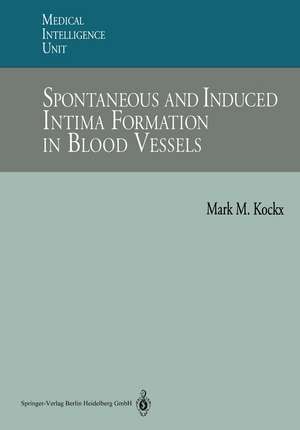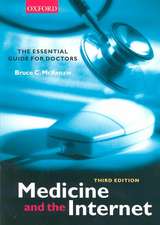Spontaneous and Induced Intima Formation in Blood Vessels: Medical Intelligence Unit
Autor Mark M. Kockxen Limba Engleză Paperback – 20 noi 2013
This volume considers all aspects of intima formation based on results which had been obtained by studying three different models:
- Spontaneous intima formation;
- Experimentally induced intima formation;
- Latrogeneously induced intima formation.
Din seria Medical Intelligence Unit
- 5%
 Preț: 367.28 lei
Preț: 367.28 lei - 5%
 Preț: 367.64 lei
Preț: 367.64 lei - 18%
 Preț: 945.79 lei
Preț: 945.79 lei -
 Preț: 392.37 lei
Preț: 392.37 lei - 15%
 Preț: 630.88 lei
Preț: 630.88 lei - 5%
 Preț: 1090.97 lei
Preț: 1090.97 lei - 5%
 Preț: 715.19 lei
Preț: 715.19 lei - 5%
 Preț: 1100.30 lei
Preț: 1100.30 lei - 5%
 Preț: 367.84 lei
Preț: 367.84 lei - 5%
 Preț: 981.70 lei
Preț: 981.70 lei - 5%
 Preț: 1424.31 lei
Preț: 1424.31 lei - 20%
 Preț: 559.19 lei
Preț: 559.19 lei - 5%
 Preț: 1094.97 lei
Preț: 1094.97 lei - 5%
 Preț: 783.04 lei
Preț: 783.04 lei - 18%
 Preț: 942.31 lei
Preț: 942.31 lei - 5%
 Preț: 367.28 lei
Preț: 367.28 lei - 5%
 Preț: 1098.48 lei
Preț: 1098.48 lei - 5%
 Preț: 366.70 lei
Preț: 366.70 lei - 5%
 Preț: 1095.73 lei
Preț: 1095.73 lei - 5%
 Preț: 368.73 lei
Preț: 368.73 lei - 5%
 Preț: 1092.99 lei
Preț: 1092.99 lei - 5%
 Preț: 1093.88 lei
Preț: 1093.88 lei - 5%
 Preț: 1086.58 lei
Preț: 1086.58 lei - 5%
 Preț: 1417.75 lei
Preț: 1417.75 lei - 5%
 Preț: 362.88 lei
Preț: 362.88 lei - 5%
 Preț: 980.66 lei
Preț: 980.66 lei - 5%
 Preț: 715.35 lei
Preț: 715.35 lei - 5%
 Preț: 1092.79 lei
Preț: 1092.79 lei - 5%
 Preț: 365.61 lei
Preț: 365.61 lei - 5%
 Preț: 715.00 lei
Preț: 715.00 lei - 5%
 Preț: 364.53 lei
Preț: 364.53 lei - 5%
 Preț: 1097.18 lei
Preț: 1097.18 lei - 5%
 Preț: 1095.54 lei
Preț: 1095.54 lei - 5%
 Preț: 716.28 lei
Preț: 716.28 lei - 15%
 Preț: 644.49 lei
Preț: 644.49 lei - 5%
 Preț: 714.46 lei
Preț: 714.46 lei - 5%
 Preț: 1478.11 lei
Preț: 1478.11 lei - 18%
 Preț: 943.88 lei
Preț: 943.88 lei - 5%
 Preț: 1096.81 lei
Preț: 1096.81 lei -
 Preț: 384.07 lei
Preț: 384.07 lei
Preț: 708.58 lei
Preț vechi: 745.88 lei
-5% Nou
Puncte Express: 1063
Preț estimativ în valută:
135.58€ • 141.56$ • 112.21£
135.58€ • 141.56$ • 112.21£
Carte tipărită la comandă
Livrare economică 04-18 aprilie
Preluare comenzi: 021 569.72.76
Specificații
ISBN-13: 9783662224328
ISBN-10: 3662224321
Pagini: 128
Ilustrații: IX, 111 p. 78 illus., 1 illus. in color.
Dimensiuni: 178 x 254 x 15 mm
Greutate: 0.24 kg
Ediția:Softcover reprint of the original 1st ed. 1995
Editura: Springer Berlin, Heidelberg
Colecția Springer
Seria Medical Intelligence Unit
Locul publicării:Berlin, Heidelberg, Germany
ISBN-10: 3662224321
Pagini: 128
Ilustrații: IX, 111 p. 78 illus., 1 illus. in color.
Dimensiuni: 178 x 254 x 15 mm
Greutate: 0.24 kg
Ediția:Softcover reprint of the original 1st ed. 1995
Editura: Springer Berlin, Heidelberg
Colecția Springer
Seria Medical Intelligence Unit
Locul publicării:Berlin, Heidelberg, Germany
Public țintă
ResearchCuprins
1. General Introduction.- 2. Intimal Cushion Formation and Diffuse Intimal Thickening in Human Lower Limb Arteries.- 3. Spontaneous Intima Formation in Rabbit Arteries.- 4. The Triphasic Sequence of Neo-Intima Formation in Cuffed Rabbit Carotid Arteries.- 5. The Endothelium During Cuff-Induced Neo-Intima Formation in the Rabbit Carotid Artery.- 6. The Relationship Between Pre-Existing Subendothelial Smooth Muscle Cell Accumulations and Foam Cell Lesions in Cholesterol-Fed Rabbits.- 7. The Early Transformation of Human Aorto-Coronary Saphenous Vein Grafts.- 8. The Thickened Intima in Long-Standing Aorto-Coronary Saphenous Vein Grafts.- 9. Summary and General Conclusion.- Appendix—General Methods.- Standard Histological Techniques.- Immunohistochemical Techniques.- Transmission Electron Microscopy.- Scanning Electron Microscopy.














